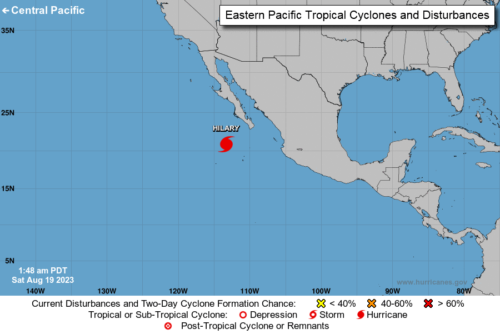Coast Guard Sectors San Diego monitoring Hurricane Hilary

By SDCN Editor
San Diego, CA–The Captain of the Port for Coast Guard Sectors San Diego is actively monitoring Hurricane Hilary, which strengthened from a tropical storm to a hurricane on Thursday and is forecasted to bring significant rainfall and high winds to Southern California this weekend.
According to the National Hurricane Center, Hilary is about 60 miles southwest of Socorro Island, Mexico, with maximum wind gusts of 75 mph. While the hurricane will likely weaken as it travels northward, it could bring heavy rainfall to the southwestern United States, along with large swells and high surf along the coast.
A tropical storm watch is in effect for parts of Mexico before approaching the Baja California peninsula this weekend. The storm could produce up to eight inches of rain across the peninsula through Monday morning, with the potential for flash flooding.
Hurricanes and tropical storms rarely make landfall in the state; the last tropical storm to impact California was more than 84 years ago. That storm occurred in 1939 and was only preceded by one other known hurricane, which made landfall in 1858.
Hurricane Hillary has the potential to impact southern California. Hazards include high surf, dangerous rip currents, and undertow conditions, heavy winds, heavy rainfall, and coastal flooding.
“One of the Coast Guard’s priorities is the safety of life at sea, and mariners are reminded sea state conditions could be above normal limitations beyond a recreational boat and to be cognizant that these storms can be unpredictable,” said Capt. James Spitler, commander of Sector San Diego.”
The Coast Guard is warning the public of these important safety messages:
- Stay off the water. The Coast Guard’s search and rescue capabilities degrade as storm conditions strengthen. This means help could be delayed. Boaters should heed weather watches, warnings, and small craft advisories.
- Evacuate as necessary. If mandatory evacuations for an area, the public should evacuate without delay. Coast Guard personnel and other emergency responders may be unable to evacuate or rescue those in danger during the storm.
- Secure belongings. The Coast Guard urges owners of large boats to move their vessels to inland marinas where they will be less vulnerable to breaking free of their moorings or sustaining damage. Boatowners should pull trailerable boats from the water and store them in a place not prone to flooding. Boat owners leaving their vessels in the water should remove EPIRBs and secure life rings, lifejackets, and small boats. If not properly secured, these items can break free, causing the diversion of valuable search and rescue resources to ensure people are not in distress.
- Stay clear of beaches. Wave heights and currents typically increase before a storm makes landfall. Even the best swimmers can fall victim to the strong waves and rip currents caused by hurricanes. Swimmers should stay clear of beaches until local lifeguards and law enforcement officials say the water is safe.
- Be prepared. Area residents should be prepared by developing a family plan, creating a disaster supply kit, having a place to go, securing their homes, and having a plan for pets. Visit the National Hurricane Center’s webpage for more information.
- Stay informed. The public should monitor the progress and strength of the storm through local television, radio, and the Internet. Boaters can monitor their progress on VHF radio channel 16. Small craft advisories and warnings are broadcast on VHF radio channel 16.
For more information, visit the National Hurricane Center’s webpage for information on the storm’s progress and hurricane preparedness.





